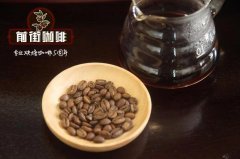African Coffee Bean Origin Uganda Sun-baked Coffee Flavor Taste Characteristics Introduction

Professional coffee knowledge exchange more coffee bean information please follow the coffee workshop (Wechat official account cafe_style)
Introduction of Ugandan Portuguese Coffee in Qianjie
The territory of Uganda is mostly a plateau about 1200 meters above sea level, and there are many lakes, known as "plateau water villages." Lake Victoria, the second largest freshwater lake in the world, has 42.8% of its area in Uganda. In short, the country is not short of water.
The country is on the equator, and most areas belong to the savanna climate, but because of the relatively high terrain, the year is only divided into dry season and rainy season. Coupled with the vertical and horizontal lakes and rivers, abundant rainfall, luxuriant plants, the average annual temperature is only about 23 degrees Celsius. It's so suitable for growing coffee.
In fact, the production of Arabica beans (Arabica) accounts for only about 15% of Uganda's total coffee production, what about the rest? It's all Robusta. Large areas of robusta coffee trees naturally grow in Kibale Forest National Forest Park in southern Uganda.
Coffee is grown in 112 areas of the country.
Robusta coffee is grown at low elevations in central, eastern, western and southeastern Uganda, up to 1200 meters above sea level.
Arabica coffee is grown in the highlands of the slopes of Mount Mount Elgon in the east and Mt in the southwest. Rwenzori and Mt. Muhabura (altitude 1500-2300 m).
Ugandan coffee processing is mainly wet processing (washing) and dry (solarization) processing. Most of the robusta coffee is processed by daily dry method, but also a small part of it is processed by wet method. Generally speaking, the quality of wet processing is higher than that of dry processing. There are 537 dry processing plants and 22 wet processing plants in Uganda
Uganda, Portugal.
Producing area: Mount Elgon, Uganda
Altitude: 1600-1850 m
Treatment method: anaerobic fermentation and solarization
Variety: SL14&SL28
Flavor: it smells fermented and slightly sour, with sour notes of grapes, citrus, lime and berries in the mouth, creamy in the middle, sweet caramel and cocoa in the end, with a sense of juice, and the whole bean tastes thick.
END
Important Notice :
前街咖啡 FrontStreet Coffee has moved to new addredd:
FrontStreet Coffee Address: 315,Donghua East Road,GuangZhou
Tel:020 38364473
- Prev

What are the characteristics of Arabica coffee beans Uganda coffee beans taste Uganda coffee beans
Professional coffee knowledge exchange More coffee bean information Please pay attention to coffee workshop (Weixin Official Accounts cafe_style) Front Street Uganda Coffee Introduction Uganda is a landlocked country in Africa without sea, spanning the equator, bordering Kenya in the east, Tanzania and Rwanda in the south, Congo (Kinshasa) in the west, South Sudan in the north, most of Uganda is located in the East African plateau, with many lakes, with an average altitude of 1000~1
- Next

A brief introduction to the flavor characteristics of water-washed Yejiaxuefei
Professional coffee knowledge exchange more coffee bean information please follow the coffee workshop (Wechat official account cafe_style) the front street of the coffee workshop Yega Xuefei Agaroftu Valley Dina Cooperative washing introduction Yega Xuefei is actually a small town, is an area of Sidamo Province in Ethiopia, because of its unique flavor and reputation, almost become Ethiopia's boutique coffee
Related
- Beginners will see the "Coffee pull flower" guide!
- What is the difference between ice blog purified milk and ordinary milk coffee?
- Why is the Philippines the largest producer of crops in Liberia?
- For coffee extraction, should the fine powder be retained?
- How does extracted espresso fill pressed powder? How much strength does it take to press the powder?
- How to make jasmine cold extract coffee? Is the jasmine + latte good?
- Will this little toy really make the coffee taste better? How does Lily Drip affect coffee extraction?
- Will the action of slapping the filter cup also affect coffee extraction?
- What's the difference between powder-to-water ratio and powder-to-liquid ratio?
- What is the Ethiopian local species? What does it have to do with Heirloom native species?

